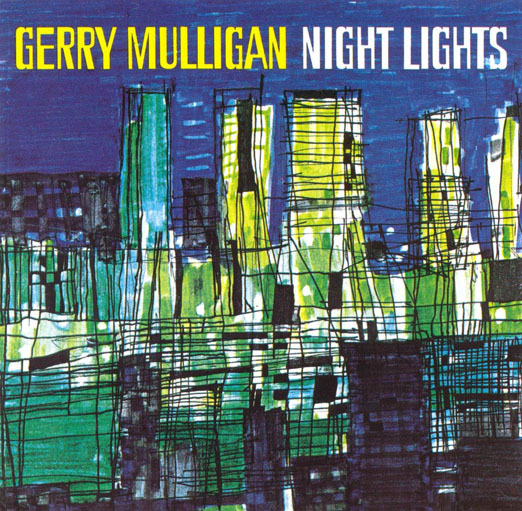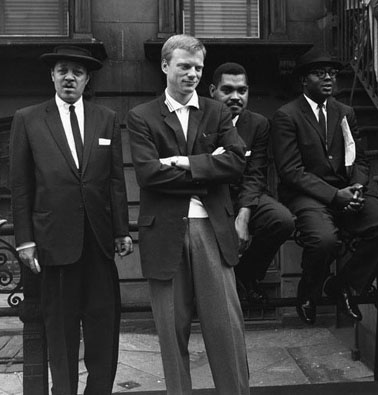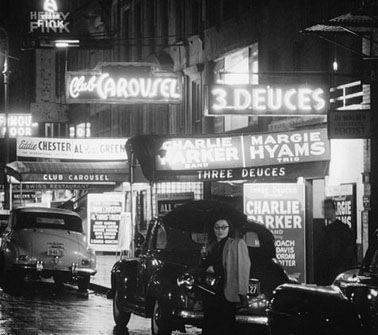Memories of Gerry Mulligan and other time travelers in the strange North American summer of 2017
Jul 15th, 2017 | By Dominic Berry | Category: Entertainment
You can now buy Grace Lake Island in Haliburton, and “Create Your Own Private Escape” for $250,000 C – without electricity or anything else (but lots of mosquitoes in such a nicely wooded place).
At last we have summer in the city 2017 up here on the northwest shore of the most easterly great lake (well, sort of …). Back from a short communion with early July mosquitoes further north, I somehow bumped into a YouTube clip called “Paul Desmond & Gerry Mulligan – Stardust.”
As happens in the digital age this led to a slightly longer look at the “cool jazz” great Gerry Mulligan (6 Apr 1927 — 20 Jan 1996) – first encountered in my misspent youth many years ago.
I have just learned from a quite good Wikipedia article that Mulligan died in 1996 at 68. This summer I am remembering someone very close who also played music and died at 68, in 2017.
One side of him would just raise his eyebrows and say “@#$% Gerry Mulligan : I don’t like jazz.” Another side might allow a few thoughts (no more) on the virtues of living until you’re 68 and still doing quite a lot with your life.
* * * *
 Myself I like jazz. And Gerry Mulligan played a role in my discovery of the larger world beyond the near suburbs and old city north end where I lived as a teenager, from 1958 to 1964.
Myself I like jazz. And Gerry Mulligan played a role in my discovery of the larger world beyond the near suburbs and old city north end where I lived as a teenager, from 1958 to 1964.
(I can even remember a local magazine article from the time, that claimed to examine both sides of a troubled marriage : “My wife’s a mental midget” vs. ”My husband’s an intellectual snob.” I later discovered both sides were written by the local literary survivor Hugh Garner, in an earlier tradition of fake news. One of the wife’s main complaints was that her husband listened too much to Gerry Mulligan records.)
On the view I absorbed in my teenage years Mulligan’s main talent was as an arranger (and composer). Yet as Wikipedia notes for “42 consecutive years (1953—1995)”he also won “the Down Beat magazine reader’s poll for outstanding baritone saxophonist.”
Mulligan was was not deft technically on the still somewhat unusual baritone (the heaviest of the big 4 saxophones to carry). But he cultivated an attractive tone, and used his arranger’s skill to craft tuneful and largely uncomplicated improvisations.
“There are some words,” he declared (later in life, I believe, after he married the Contessa) “that have been lost from modern usage that I like to bring to my music and have striven all my life to do, BEAUTY, GRACE, NOBILITY.”
(Or as the compelling user review jazz writer Don Bays has somewhat differently but still similarly explained, in his droll assessment of Mulligan’s 1963 album, Night Lights : “This is perfect bachelor pad music but actually stands up to serious examination quite well.” And if anyone ever said anything like this about something I’d done, I’d be very pleased.)
* * * *
Gerry Mulligan’s earliest years also suggest something about what he brought to his music. He was the youngest of four brothers, born in 1927 to a white middle-class family with an engineer father/breadwinner who moved around quite a lot in the US Northeast and near Midwest.

From the 1958 “Great Day in Harlem” photo of New York jazz musicians – l to r : Lester Young, Gerry Mulligan, Art Farmer, Gigi Gryce. Photo : Art Kane.
Mulligan was born in Queen’s, New York City. But his family soon moved to Marion, Ohio, where they stayed for a while.
As Wikipedia explains : “With the demands of a large home and four young boys to raise, Mulligan’s mother hired an African-American nanny named Lily Rose, who became especially fond of the youngest Mulligan.” And, legend has it, from Ms Rose and her family Gerry Mulligan first learned about jazz. (Though on the current Mulligan website the influential lady involved is – presumably more accurately? – identified as Lily Rowan.)
The Mulligan family moved again (and again) – to southern New Jersey, Chicago, Kalamazoo (Michigan), Detroit, Reading (Pennsylvania), and finally to Philadelphia.
In the early 1940s Gerry began playing clarinet and trying to arrange dance-band music, at a Catholic school in Kalamazoo.
Then, as Wikipedia explains, “in Reading, Mulligan began studying clarinet with dance-band musician Sammy Correnti, who also encouraged Mulligan’s interest in arranging.” And, rather precociously, he “began playing saxophone professionally in dance bands in Philadelphia.”
Soon enough, Wikipedia reports, the Mulligan family itself was in “Philadelphia, where Gerry attended the West Philadelphia Catholic High School for Boys and organized a school big band, for which he also wrote arrangements.”
And then : “When Mulligan was sixteen, he approached Johnny Warrington at local radio station WCAU about writing arrangements for the station’s house band. Warrington was impressed and began buying Mulligan’s arrangements … Mulligan dropped out of high school during his senior year to pursue work with a touring band.”
* * * *
The rest, as they say is history. And – remembering only “a few thoughts (no more)” are relevant for my purposes here – I’ll just quickly add: If you want to pursue the story further the Wikipedia article is as good a place to start as I can think of (not perfect of course, but …)
There is also a Gerry Mulligan website maintained, it seems, by his wife, the former Contessa Franca Rota Borghini Baldovinetti (later Franca Rota Mulligan). For those who are especially interested, the Library of Congress website has a Gerry Mulligan Collection online. And Jeru’s Journey : The Life & Music of Gerry Mulligan, by Sanford Josephson, was published in 2015.
As with any musician, however, the best place to start is with the music. In the age of YouTube on the world wide web, that is a lot easier than it used to be.
The first thing on the music I would do myself, if I were coming fresh to the scene, so to speak, is consult another quite good Wikipedia article on “Birth of the Cool.”
This is the story of how, in the late 1940s and early 1950s, Miles Davis, Gil Evans, Gerry Mulligan, and other racially mixed habitués of Evans’s apartment “with bare heating pipes behind a Chinese laundry at 14 West 55th Street in midtown Manhattan” experimented with one of the several vital streams of modern jazz to emerge from the early 1940s innovations of Charlie Parker, Dizzy Gillespie, Thelonious Monk, and their colleagues.
After perusing this Wikipedia article I’d then listen to at least a little of the collection of the original 1949 and 1950 “Birth of the Cool” recordings released by Capitol records in 1989, based on an earlier collection from 1957.
I could go on … but … anything I would cover here is already in Wikipedia, and I’ve already taken up too much space. I’ll just content myself with three final YouTube-based musical allusions :
* NIGHT LIGHTS. I actually don’t remember the Mulligan album Night Lights from 1963, apparently meant to take advantage of the bossa nova craze then in motion. But when I listen to it now on YouTube it seems to stand for a lot of what I liked about Gerry Mulligan in my misspent youth. It is also the one of Gerry Mulligan’s many achievements that won Don Bays’ praise as “perfect bachelor pad music” that “stands up to serious examination quite well.” (And maybe that’s my musical ideal too?)
* EVERY TIME WE SAY GOODBYE. While looking for Mulligan-related material on YouTube I inadvertently bumped into a video of Jacqui Dankworth singing an especially poignant version of the Cole Porter classic “Every Time We Say Goodbye” at a concert in Liverpool (UK), April 8, 2015. She is accompanied only by piano. And this reminded me that “Every Time We Say Goodbye” was a favourite tune of the someone very close I am remembering this summer who also played piano and died at 68, in 2017. In a related spirit note the version of the same tune offered (apparently in 2003) by Rod Stewart – accompanied by a giant, attractive, and musically excellent lady tenor saxophone player, who might make the piano player I’m remembering smile.
* OUR HOUSE. Every time I remember any loss of life nowadays I also cannot help remembering someone else very close who left our planet far too early in the bitter cold winter of 2014. I take some comfort from knowing that in all three cases – Gerry Mulligan in 1996, and my two very close memories in 2014 and 2017 (to say nothing of Charlie Parker, John Coltrane, and on and on) – the people involved accomplished a great deal that was worthwhile in their time among the living.
My two personal cases of course never became as justifiably famous as Gerry Mulligan – like most of the rest of us (and certainly me). Yet, democrat that I am to the end, I cannot help believing that what they achieved was somehow just as important, and certainly for me and others they knew just as worthwhile.
For both cases a final piece of commemorative music also instantly springs to mind : the Crosby, Stills, Nash & Young classic of 1970, “Our House.” This can similarly be supplemented with an interesting Wikipedia article, “Our House (Crosby, Stills, Nash & Young song)” – which explains how Graham Nash gave birth to the song in about an hour, in a house on Laurel Canyon in L.A. where he lived with Joni Mitchell and her two cats. (And this would similarly resonate agreeably, I think, with both my two very close memories, if not exactly with Gerry Mulligan, unless the house were some villa in north-central Italy owned by his wife, the former Contessa Franca Rota Borghini Baldovinetti.)
In any case very best wishes to all for the rest of the summer we seem to be having, whether we like it or not. Stay cool and all that.






Thanks for mentioning my book, Jeru’s Journey: The Life and Music of Gerry Mulligan, in your July 15th column about Gerry. If you would like the publisher to send you a review copy, please let me know. Gerry is truly one of the giants of American music, and I don’t believe he has been given the due that he deserves. He may not be the equal of Duke Ellington, but he belongs in the same category — as a composer, arranger, bandleader and baritone saxophonist.
What a wonderful article…….so rich in history and beautifully written. As the Executive Director of the Gerry & Franca Mulligan Foundation, we carry on Gerry’s legacy by sharing his music with schools, providing high-quality instruments to young musicians in need, and providing grants and scholarships. We strive to share BEAUTY, GRACE, NOBILITY – just as Gerry did in his music. Thank you again for a beautiful article.